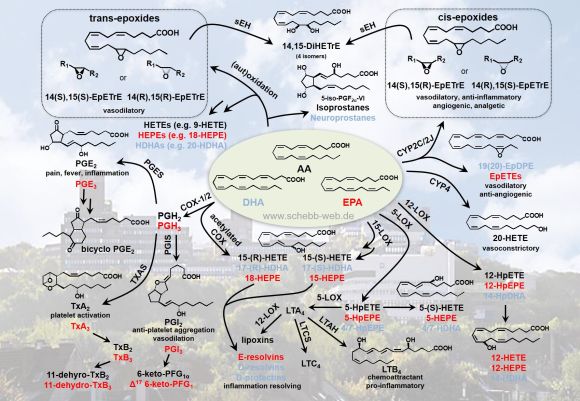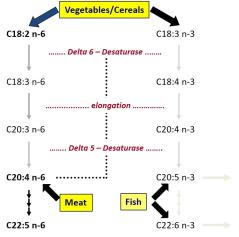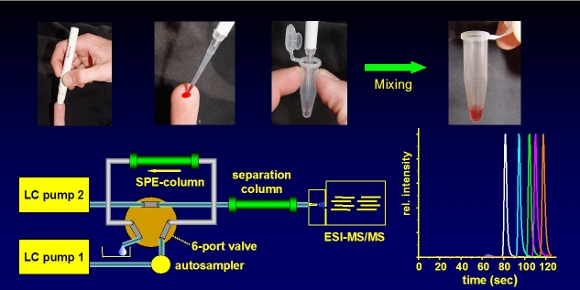Research
Basically, our research aims to contribute to answering the questions: “How does food affect our health?” and “What is the healthiest diet for me?”
More specifically, we investigate the biological activity of food ingredients and the resulting beneficial or adverse effects on human health. Here, we focus on one class of endogenous messengers-lipid-mediators called “oxylipins”, which regulate various physiological functions, such as inflammation and pain.
The current projects:
- How do food ingredients modulate oxylipin formation?
- What is the molecular mechanism of the beneficial health effects of omega 3?
- How does the fat(ty acid) composition of the diet modulate the endogenous oxylipin pattern?
- Development of targeted metabolomics methods

Conversion of unsaturated fatty acids to bioactive oxylipins
How do food ingredients modulate oxylipin formation?
Eicosanoids and oxidative metabolites of other poly-unsaturated fatty acids represent one of the most potent classes of endogenous cellular mediators. Although about 80% of pharmaceuticals influence the formation of these oxylipins, little is known with regard to alteration of their distribution pattern caused by food ingredients. We work on the identification of those food ingredients that potently alter the enzymatic or non-enzymatic routes of oxylipin formation and elucidate their mechanistic mode of action. Physiological effects of the resulting changes in the oxylipin pattern are investigated in different models of inflammation. Overall the obtained data will help to understand the general influence of food on inflammation and will thus help to identify a diet, which is beneficial for humans suffering from chronic inflammatory diseases.
Related funding:
2011-2015: Marie Curie Grant of the European Union
2014- present: Grant (SCHE 1801/4-1) of the German Research foundation (DFG)
Related publications:
I. Willenberg, A. K. Meschede, F. Güler M.S. Jang, N. Shushakova and N. H. Schebb (2015) Food polyphenols fail to cause a biologically relevant reduction of COX-2 activity. PLOS-1, 10.1371/journal.pone.0139147.
What is the mechanism of the beneficial health effects of omega 3?
The intake of the long-chain omega-3 n3-polyunsaturated fatty acids (n3-PUFA) DHA and EPA has triglyceride and blood pressure lowering as well as anti-inflammatory effects. However, the mechanisms of how these essential food ingredients elicit their health effects are controversial. Aim of this project is to investigate the preventive and curative impact of n3-PUFA oxylipins, particular epoxy-FA and hydroxy-FA, on chronic inflammatory diseases.
Related funding:
2015- present: Grant (SCHE 1801/6-1) of the German Research foundation (DFG)
Related publications:
I. Willenberg, S. Rong, N. Shushakova, F. Gueler and N. H. Schebb (2016) Characterization of changes in plasma and tissue oxylipin levels in LPS and CLP induced murine sepsis. Inflamm Res. 65 (2), 133-42.
I. Willenberg, A.I. Ostermann, O. Kershawb, S. Giovanninib, A. v. Keutz, P. Steinberg and N.H. Schebb (2015) Effect of acute and chronic DSS induced colitis on plasma eicosanoid and oxylipin levels in the rat. Prostag Oth Lipid M, 120, 155-160.
B. Inceoglu; K.M. Wagner; J. Yang, A. Bettaieb, N.H. Schebb, S.H. Hwang, C. Morisseau, F. Haj and B.D. Hammock (2012) Acute augmentation of epoxygenated fatty acid levels rapidly reduces pain-related behavior in a rat model of type I diabetes. Proc Natl Acad Sci U S A 109 (28), 11390-5.
B. Inceoglu, K. Wagner, N.H. Schebb, C. Morisseau, S. L. Jinks, C. Hegedus, A. Ulu, R. Brosnan, A. L. Morrow and B.D. Hammock (2011) Epoxy-fatty acid produced antinociception is driven by pain and elevated cAMP. PNAS, 108, (12), 5093-7.
How does the fat(ty acid) composition of the diet modulate the endogenous oxylipin pattern?

Essential nutrients PUFA: Desaturation and elongation of n6-PUFA and n3-PUFA
Polyunsaturated fatty acids (PUFA) are metabolized by a complex network of conversion, retro-conversion and oxidation. The aim of the project is to investigate systematically the metabolism of n-3 PUFA and n-6 PUFA to hydroxy-, epoxy- and dihydroxy-FA in healthy humans. These studies will provide fundamental knowledge on short and long term changes in oxylipin profiles in blood and urine. Moreover, detailed blood fatty acid profiles following the intake of different PUFA in varying ratios of the n-3/n-6 precursor fatty acids will be obtained, allowing to evaluate uptake, bioavailability, and distribution of PUFA.
Related funding:
2015- present: Grant (SCHE 1801/7-1) of the German Research foundation (DFG)
Related publications:
PK. Moeller, A.I. Ostermann , K. Rund , S. Thoms , C. Blume , F. Stahl , A. Hahn, N.H. Schebb, J.P. Schuchardt (2016) Influence of weight reduction on blood levels of C-reactive protein, tumor necrosis factor-α, interleukin-6, and oxylipins in obese subjects. Prostag Leukotr Ess, doi: 10.1016/j.plefa.2015.12.001
N.H. Schebb, A.I. Ostermann, J. Yang, B.D. Hammock, A. Hahn and J.P. Schuchardt (2014) Comparison of the effects of long-chain omega-3 fatty acid supplementation on plasma levels of free and esterified oxylipins. Prostag Oth Lipid M, 113-115, 21-29.
J.P. Schuchardt, I. Schneider, I. Willenberg, J. Yang, B.D. Hammock, A. Hahn and N.H. Schebb (2014) Increase of EPA-derived hydroxy, epoxy and dihydroxy fatty acid levels in human plasma after a single dose of long-chain omega-3 PUFAs. Prostag Oth Lipid M. 109-111, 23–31.
J.P. Schuchardt, S. Schmidt, G. Kressel, H. Dong, I. Willenberg, B.D. Hammock, A. Hahn and N.H. Schebb (2014) Modulation of blood oxylipin levels by long-chain omega-3 fatty acid supplementation in hyper- and normolipidemic men. Prostag Leukotr Ess. 90, 27-37.
P. Schuchardt, S. Schmidt, G. Kressel, H. Dong, I. Willenberg, B.D. Hammock, A. Hahn and N.H. Schebb (2013) Comparison of free serum oxylipin concentrations in hyper- vs. normolipidemic men. Prostag Leukotr Ess, 89, 19-29.
Development of targeted metabolomics methods
Numerous studies on the impact of nutrition and drugs, as well as different diseases on single eicosanoids have been carried out. However, for biological effects arise from a multitude of oxylipins this approach is incomplete. To solve this problem, we have developed targeted metabolomics approachs allowing to analyze simultaneously a comprehensive oxylipin pattern of all unsaturated fatty acids using liquid chromatography mass spectrometric methods (LC-MS).
A list of those oxylipins currently covered by our LC-MS method together with information about the limits of detection and the dynamic range of the method can be found here
(pdf). We provide oxylipin analysis of biological samples (e.g. blood, tissue, cell culture samples) for other research groups on a collaborative base. Please contact Dr. Schebb in case you are interested in collaboration.
Related funding:
2011-2015: Marie Curie Grant of the European Union
2014- present: Grant (SCHE 1801/5-1) of the German Research foundation (DFG)
Related publications:
I. Willenberg, A.I. Ostermann and N.H. Schebb (2015) Targeted metabolomics of the arachidonic acid cascade - Current state and challenges of LC-MS analysis of oxylipins. Anal Bioanal Chem, 407, 2675–2683.
A.I. Ostermann, I. Willenberg and N.H. Schebb (2015) Comparison of sample preparation methods for the quantitative analysis of eicosanoids and other oxylipins in plasma by means of LC-MS/MS. Anal Bioanal Chem, 407(5),1403-1414.
I. Willenberg, A.K. Meschede and N.H. Schebb (2015) Determining COX-2 activity in three different test systems utilizing online-solid phase extraction-liquid chromatography-mass spectrometry for parallel quantification of prostaglandin E2, D2 and thromboxane B2. J Chromatogr A 1391, 40-48.
A.I. Ostermann, I. Willenberg, K.W. Weylandt and N.H. Schebb (2015) Development of an online-SPE-LC-MS/MS method for 26 hydroxylated polyunsaturated fatty acids as rapid targeted metabolomics approach for the LOX, CYP and autoxidation pathways of the arachidonic acid cascade. Chromatographia, 78(5), 415-428.
A.I. Ostermann, M. Müller, I. Willenberg and N.H. Schebb (2014) Determining the fatty acid composition in plasma and tissues as fatty acid methyl esters by gas chromatography – A comparison of different derivatization and extraction procedures. Prostag Leukotr Ess. 91, 235-241.
ADME of food ingredients and contaminants

Scheme of fast and easy blood sampling followed by fully automated online-SPE-LC-MS analysis
A compound can only elicit biological effects, if it reaches the tissue in sufficient concentrations. Thus, the investigation of absorption, distribution, metabolism, and excretion (ADME) of drugs is a key element in the development of pharmaceuticals. However, in most cases the information about ADME of food ingredients and toxicants is scarce.
In order to fill this gap, we develop analytical tools for the fast investigation of food ingredients, contaminants, and residues concerning pharmacokinetics (PK).Several in vitro (cell fractions, such as microsomes and primary hepatocytes) and in vivo techniques for the investigation of the metabolism of food ingredients are carried out in the lab. In order to investigate the fate of compounds in the food chain, we have established a small library of liver fractions from livestock (e.g. cattle, pigs, but also laboratory animals, such as rats). These fractions (cytosol, microsomes) are available for other researchers on a collaborative basis. Please contact Dr. Schebb in case you are interested to cooperate in the field of xenobiotica metabolism.
Related funding:
2012-2014: Grant of the Danone Fundation
Related publications:
I. Willenberg, M. Michael, J. Wonik and N.H.Schebb (2015) Investigation of the effects of soluble fibers on the absorption of resveratrol and of 2-amino-1-methyl-6-phenylimidazo[4,5-b]pyridine (PHIP) in the Caco-2 cellular model of intestinal absorption. Int J Food Sci Nutr, 66 (6), 677-679.
I Willenberg, L.v. Elsner, P. Steinberg and N.H. Schebb (2014) Development of an online-SPE-LC-MS method for the investigation of the intestinal absorption of PHIP and its bacterial metabolite PHIP-M1 in a Caco-2 Transwell system. Food Chem, 166, 537–543.
I. Willenberg, M. Michael, J. Wonik, L.C. Bartel, M.T. Empl and N.H.Schebb (2015) Investigation of the absorption of resveratrol oligomers in the Caco-2 cellular model of intestinal absorption. Food Chem. 167, 245–250.
I. Willenberg, W. Brauer, M.T. Empl and N.H. Schebb (2012) Development of a rapid LC-UV Method for the Investigation of chemical and metabolic Stability of Resveratrol Oligomers. J Agric Food Chem 60 (32), 7844-7850.
R. Maul, B. Warth, J.S. Kant, N.H.Schebb, R.Krska, M.Koch and M. Sulyok (2012) Investigation of the hepatic glucuronidation pattern of the Fusarium mycotoxin deoxynivalenol in various species. Chem. Res. Tox. 25, 2715-2717.